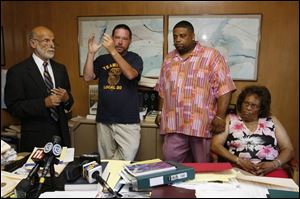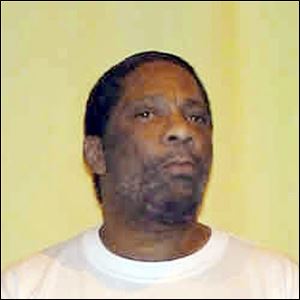
Family sues over botched Ohio execution
7/3/2007
Toledo attorney Alan Konop left, listens as Michael Manning, speaks about the execution of Joseph Clark last year. With them are Clark's brother Dennis Clark and mother, Erma Clark.

Toledo attorney Alan Konop left, listens as Michael Manning, speaks about the execution of Joseph Clark last year. With them are Clark's brother Dennis Clark and mother, Erma Clark.
When Michael Manning arrived to witness the May, 2006, execution of Joseph Lewis Clark, he was intent on watching justice served against his brother's killer.
Yesterday, Mr. Manning stood shoulder to shoulder with Clark's brother to speak out against the lengthy and seemingly painful execution.
Mr. Manning joined members of the Clark family as they spoke about a lawsuit filed early yesterday in U.S. District Court in Cincinnati. Filed by Clark's mother, Irma Clark, the lawsuit asks for monetary damages. But those involved said that the larger goal is to achieve change.
"I believe in the constitutionality part of [the death penalty]," said Mr. Manning, who is not a party in the lawsuit. "Even though I do believe in the death penalty, I also believe that no one should have to die a horrible death and that's what Joseph did, died a horrible death."
Mr. Manning admitted that many members of his family do not agree with his alliance with the Clark family.
Those who witnessed Clark's execution saw a procedure that typically lasts approximately 10 minutes drag into one that lasted 86 minutes.
The execution team struggled for 25 minutes to find usable veins in Clark's arms before making the decision to proceed with just one intravenous shunt in his left arm.

Joseph Clark
After uttering his final words, Clark lay extremely still, breathing shallowly.
A witness described the scene as one where Clark appeared to have fallen asleep, except for the occasional movement of his feet.
But after a few moments, Clark raised his head, shook it back and forth, and repeatedly declared, "It don't work."
Prior to his arrest, Clark had been a longtime intravenous drug user.
The execution team then closed a curtain to block witnesses' view of the execution chamber, but witnesses - including Mr. Manning - said Clark's moans and groans were audible through the glass.
Clark's brother, Dennis, said yesterday that no one from his family was at the execution per his brother's requests. He added that he does not condone his brother's actions but that he is concerned about the state's method of execution.
"What my brother did was wrong. He committed a crime, he did the time, and ultimately he paid the price," Mr. Clark said.
"I just want to see it done right," he added. "If it's done right, we wouldn't be here."
Clark was executed at the Southern Ohio Correctional Facility in Lucasville, Ohio, for the 1984 slaying of David Manning, a 23-year-old husband and father who was shot at a gas station on Airport Highway in South Toledo.
He received a life sentence for killing another clerk, Donald Harris, 21, the night before at a store on Hill Avenue.
Clark was arrested after shooting a third man, Robert Roloff, during a holdup at a bank ATM in Toledo three days after Mr. Manning's death. Mr. Roloff survived.
Attorney Alan Konop, who is representing the Clark family, said the lawsuit asks for $150,000 but ultimately any award would be up to a judge or jury. He added that more importantly, the family hopes to start an open and transparent discussion of the problems.
Clark's execution wasn't the only one plagued with problems, Mr. Konop said. On May 24, executioners had trouble inserting needles into the veins of Christopher Newton, who had insisted on the death penalty as a punishment for killing a cellmate. The execution team stuck him at least 10 times with needles to get in place the shunts through which chemicals are injected. Prison officials said the difficulty prison staff had finding Newton's veins resulted from the girth of the 6-foot, 265-pound inmate.
Mr. Konop said that both the Eighth Amendment of the U.S. Constitution and Ohio law require "a swift and humane execution procedure." He added that Clark's execution "failed to comply with these basic standards of civility."
Named in the lawsuit are Edwin Voorhies, warden of the Southern Ohio Correctional Facility, State Prisons Director Terry Collins, and 12 unnamed execution team members.
"This is an individual lawsuit by an individual family so we can merely ask for damages," Mr. Konop said. "The hope of the family is that this will give the state an opportunity to make changes."
Mr. Konop said that an independent autopsy conducted on Clark's body by Dr. L.J. Drogovic, chief medical examiner for Oakland County, Mich., concluded that Clark had numerous needle puncture wounds.
A spokesman for Attorney General's Marc Dann's office declined comment, saying that the corrections division had not yet been served the lawsuit.
Contact Erica Blake at:
eblake@theblade.com
or 419-213-2134.